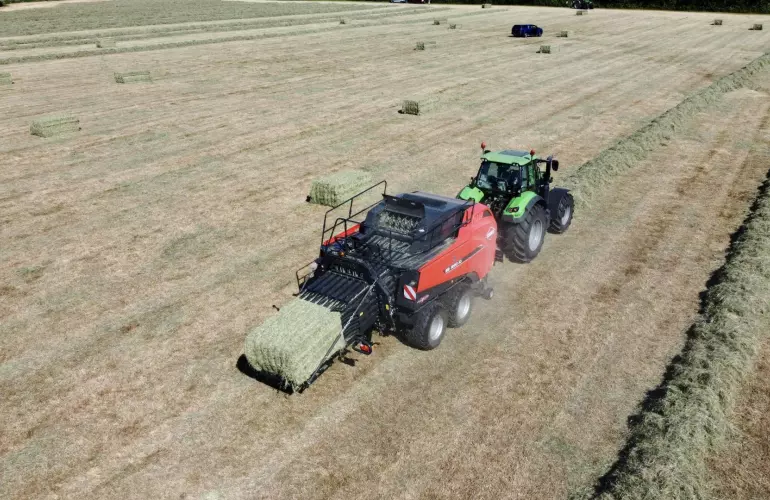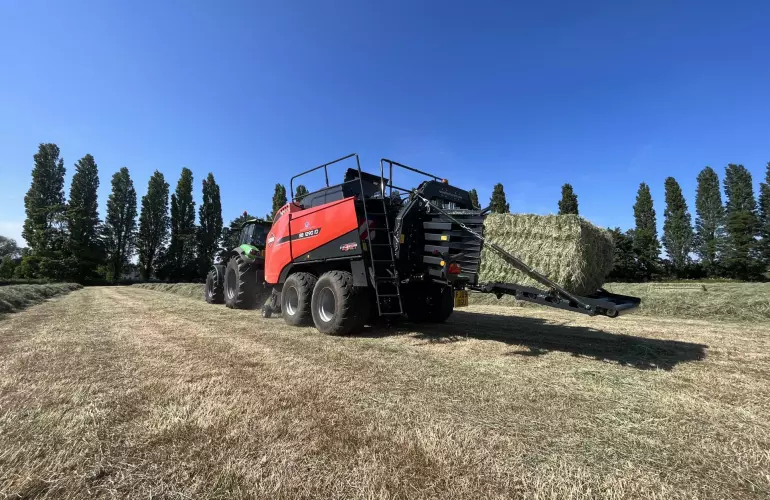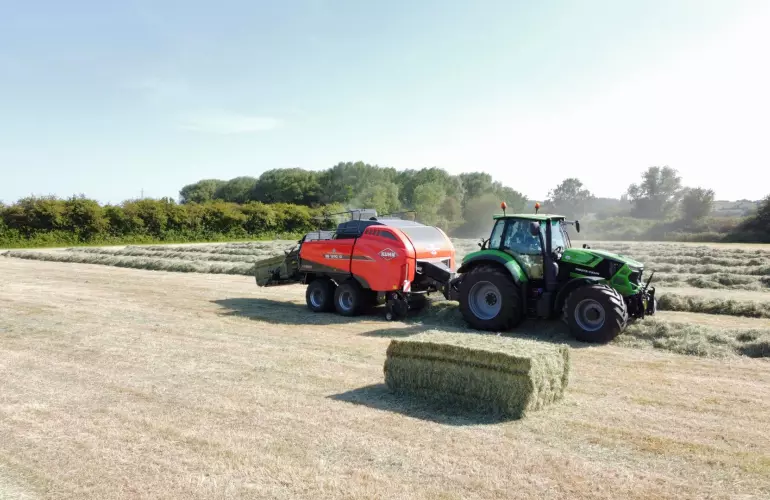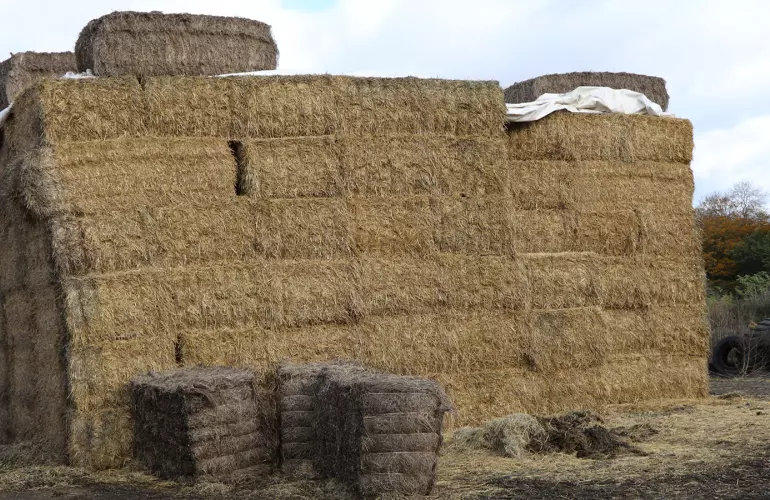Solo square baler improves bale quality
After nine years of running a four-string Lely baler, Kevan Atkin wanted to streamline his harvest baling process by adopting a larger machine to reduce labour requirements and increase daily output to clear several days of combining in one hit.

He had entertained using a contractor to bale straw and hay across his 600ha farm, but the lack of control to bale when it suited him wasn’t ideal. So, after searching the market, he eventually settled on a Kuhn SB 1290 iD to replace the older machine and admits he has been surprised by the gains made during its first full season.
“I would say we are twice as fast with the Kuhn SB baler than our previous machine as we are making bigger, better-quality bales. The increase isn’t just baling output in the field, as there are less bales to load and cart and bigger bales to use when bedding in the winter, the time saving adds up across the whole farm,” says Mr Atkin.
The mixed farm in Barrow upon Trent, Derbyshire, has a 200-strong beef suckler herd complimented by 450ha of arable land. Mr Atkin aims to be self-sufficient and 95% of the feed used for the cows is home-grown, with the farm relying heavily on straw.
“Our beef suckler herd is bedded on straw throughout the year, so we bale everything behind the combine. We run a six-straw walker machine, which leaves large fluffy swaths of straw, that has posed issues with previous balers. Part of the appeal with the Kuhn machinery is that it is well built, and it has features to save time on the farm during our busiest period.”

Double plunger benefits
The baler arrived in spring 2023 and was put straight to work baling hay. Although he hadn’t run a Kuhn baler before, he was convinced to buy one after seeing the Twinpact plunger design working at a demo and the multiple benefits it offered. Mr Atkin’s local dealer, Rea Valley Tractors, spent time making sure he knew the machine inside and out.
“I did a lot of research into the Kuhn balers and especially the double plunger Twinpact system. After trialling a few other machines, I saw the SB working and was impressed with the smooth operation and output. It also had a low power requirement for a big square baler and offered high density and a well-formed bale. We run it on our Deutz 6215 and it handles it with no issues.”
Improved bale quality in both hay and straw is one of the main benefits of the double plunger. The baler can easily achieve bale weights of 600kg in linseed, 450kg in straw, 560kg in hay crops, with Mr Atkin saying the weights are good, but a bigger positive is the consistency of each bale is identical, which makes loading and bedding-up much easier.
The Twinpact upper and lower plungers compact the bale on alternate strokes to increase the applied force per surface area. The split design also means the 485kg flywheel and driveline are the same as a standard 120x90 baler.

Smooth operator
Forward speed has a big part to play in the operation and, like any baler, it must be kept full to work at its optimum. The integral rotor and feeder forks fill the pre chamber to produce each flake before a measuring plate then releases it into the main chamber for the double plunger to form the bale. The Twinpact system aims to avoid peak loads on the baler and achieves a 25% higher bale density than a single plunger design.
Mr Atkin says the smooth operation is a big benefit. “The double plunger means there isn’t the relentless thud and subsequent rocking motion associated with a single plunger action on large square balers. We are getting denser, better-quality bales from a baler that is more enjoyable to operate.”
The consistent bale formation has offered advantages when feeding and using material in the ration. Bales are opened on the floor and used in the ration when required, with individual flakes removed without the whole bale falling apart:
“I have never seen a baler produce a bale with consistently sized flakes and a constant density as this one. Removing individual flakes like this demonstrates the quality of the formation.”
Harvest time-saving
Producing fewer denser bales as opposed to more lighter bales means less running around on stubbles during collection, which helps to lower compaction and speeds up the loading process.
A wider 2.2m pickup on the SB 1290 iD than on Mr Atkin’s old four stringer model can cope with wider fluffy swaths directly from the combine, so there isn’t as much weaving and watching the rows. The intake rotor also comes in for high praise and helps achieve the higher output, which means he is confident to combine for three days, leaving straw on the ground, with the baler capable of clearing the rows in just one day.

“Our stubbles have never been so clean, the SB 1290 iD pickup is fantastic and does a great job of collecting the straw from the deck and leaving it clear. This makes our min-till cultivations easier as we aren’t dragging patches of unbaled straw around. It also has wider 620/50 R22.5 flotation tyres to help spread the weight in the field.”
One extra Mr Atkin added was a moisture meter to keep tabs on material throughout the day. He says, although it isn’t essential, it has become a handy addition for the operator to monitor moistures, especially when baling late into the evening.
Reduced winter bedding work
Streamlining winter bedding and feeding works and keeping costs in check is also something Mr Atkin is constantly looking to do. Using homegrown feeds such a crimped barley, peas, beans, wheat and whole crop, he is controlling a large percentage of the feed supplied to his herd.
“I try to grow all the proteins for the ration and reduce the exposure to external feed cost fluctuations. When bedding up, we are saving ¾ hour per day as the bales are bigger and more time is spent spreading the bale, rather than shunting back to the stack for another. The savings are also noticed at weekends when it is usually only one person bedding up.”
Mr Atkin creates square stacks, six bales high, with the fifth row turned 90 degrees to brace the four bottom rows. This offers improved structure by preventing the end columns of bales becoming detached and potentially falling away. It also makes the stack safer for operators when removing high bales.
“We recently had a health and safety audit, and the assessor commended us on how we store the bales. It is much easier with bales that are square to build strong, safer stacks.”

Although the baler represented a large investment for the farm, the wider benefits across different aspects of the business has meant he is pleased with the decision.
“We have reduced labour demands at harvest time and when bedding up the cows through achieving better quality bales and increasing our output,” concludes Mr Atkin.
